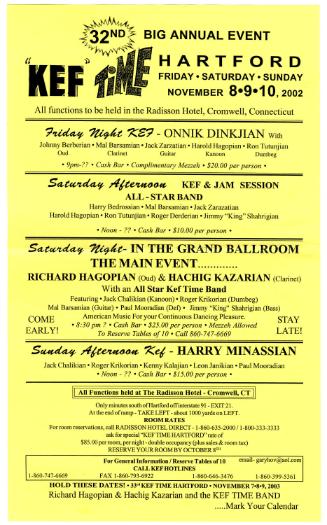Flyers: Szopka Festival
DistributorDistributed by
Polish Cultural Club of Greater Hartford
(founded 1976)
Date2012-2019
MediumPaper
ClassificationsInformation Artifacts
Credit LineConnecticut Cultural Heritage Arts Program collections
CopyrightIn Copyright
Object number2015.196.60.14-.16
Description2015.196.60.14: flyer, The 32nd Annual Szopka Festival, 2012
2015.196.60.15: flyer, The 35th Annual Szopka Competition & Festival, 2015
2015.196.60.16: flyer, The 39th Annual Szopka Festival & Competition, 2019
NotesSubject Note: The Polish community comprises nearly 10% of the state’s population, settling here during the late 19th and early 20th centuries when New England’s industrial growth made jobs plentiful in mills and factories. Thousands from rural areas of Poland left behind difficult political and economic circumstances to work in America. A similar movement of people took place in the 1980s, and Polish newcomers continue to arrive, bringing a very different sense of “Polishness” and cultural tastes from the older immigrants. Uprooted from their homeland and all that is familiar, these new Americans have found refuge in maintaining traditional customs, beliefs, foods, language, and joining together in fraternal, cultural, political, academic, and veterans societies. Parish churches fill a very important function as centers for social organization and cultural unity as well as providing spiritual and emotional comfort. The Polish saying Co kraj, to obyczaj explains that in the American Polish communities called Polonia some of the old practices change to fit new circumstances, or disappear altogether among recent generations. 2015.196.60.15: flyer, The 35th Annual Szopka Competition & Festival, 2015
2015.196.60.16: flyer, The 39th Annual Szopka Festival & Competition, 2019
The seasonal round of celebrations, festivals, holidays, along with the activities and art forms associated with them, connect Polish Americans to a dimension of beauty, meaning, spirituality, and heritage which they remember from the past but also practice today. In Connecticut works of art and everyday objects for use in the home are still made by hand in traditional Polish styles. Older objects from Poland are often redecorated with materials found here, and the process of creating and using these pieces shows an active expression of identity, not a mere recreation of old folk art forms.
New Britain, the center of Polonia in Connecticut, has a longstanding language school and folk dance group. Central Connecticut State University hosts the Polish and Polish American Studies Program and Library – one of only two such programs in the country. Broad Street is a thriving center of Polish commerce and activity, and has hosted an annual festival since 2012 called “Little Poland.” The festival is held in late April to mark Poland’s Constitution Day, a celebration of the democracy enjoyed by Americans under their country’s Constitution. In Hartford, the historically Polish neighborhood around Wyllys St/Popieluszko Court/Charter Oak Avenue included SS Cyril and Methodius Church, the Church School, the Polish National Home, and several businesses.
Community celebrations and seasonal holidays often follow the liturgical calendar of the Church. Christmas is celebrated with Pasterka, the midnight mass of the shepherds when koledy, holy carols, are sung. On the Feast of Epiphany, chalk is blessed in the church and used to inscribe door lintels with K + M + B, the initials of the three kings. At Easter, baskets of food for the Easter breakfast are blessed in the church. Processions mark Corpus Christi, the Feast of the Blessed Sacrament (and a ritual to ensure good crops) in June. In the late summer, harvest festivals called Dożynki featuring an open-air or church Mass with a blessing and distribution of bread, folk dancing, craft and food vendors are held in New Britain, Bristol, and Bridgeport/Ansonia. Harvest ornaments, large structures of wheat sheafs decorated with flowers and ribbons, are made and displayed by community artists. On All Souls Day in November Polish families visit the graves of their relatives, decorating them with candles and flowers after an outdoor mass.
One of the Polish community’s important artists, iconographer Marek Czarnecki from Bristol “writes” images of saints that convey essential theological and biographical information and embody the presence of the holy ones depicted. A respected community scholar and teacher, he also restores church statues and lectures on Polish folk traditions such as szopka-making.
Subject Note: In a continuation of the living tradition of creating nativity scenes from humble and re-used materials, the Polish Cultural Club of Greater Hartford has sponsored the szopka festival, an annual November contest and festival held for many years (until 2020) at the Polish National Home in Hartford. Children from several Greater Hartford schools create their versions of the Szopka Krakowska, designing elaborate mangers to mimic the domes, towers, balconies, and roofs of local buildings in Krakow. They use recycled materials such as juice bottles, aluminum foil, cardboard boxes, and toy figures. The tradition of making elaborate manger scenes depicting the birth of Jesus at Christmas draws from the centuries-old ancient practice of staging nativity plays in village crèches carrying a szopka as a scene or small stage. The word szopka means shed, and refers to the humble stable where Jesus was born. The Szopka Festival sponsored by the Polish Cultural Club of Greater Hartford has been held at the Polish National Home every Thanksgiving weekend for several decades.
Subject Note: The Polish Cultural Club of Greater Hartford “was established in 1976 to preserve and promote the history, culture, and customs of Poland with fellow Americans." An active organization that has held many meetings at the Polish National Home on Charter Oak Avenue in Hartford, the Club sponsors lectures, seasonal celebrations such as Wigilia at Christmas time, the annual szopka festival, and gives scholarships and support to Scouts groups. The Club collaborates with the Polish Foundation and the CCSU Polish Studies Department and Library in New Britain.
Additional audio, video, and/or photographic materials exist in the archive relating to this community and these events.
Cataloging Note: This project was made possible in part by the Institute of Museum and Library Services MA-245929-OMS-20.
Status
Not on viewPolish Cultural Club of Greater Hartford
2002-2010
















